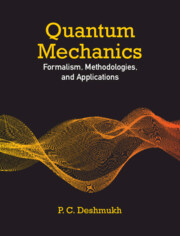Book contents
- Frontmatter
- Dedication
- Contents
- List of Figures
- Foreword
- Preface
- 1 Description of a Physical System
- 2 Path Integral Formulation of Quantum Mechanics
- 3 Probability Tangles and Eigenstates of One-dimensional Potentials
- 4 Angular Momentum
- 5 The Non-relativistic Hydrogen Atom
- 6 Approximation Methods
- 7 The Relativistic Hydrogen Atom
- 8 Quantum Mechanics of Spectral Transitions
- 9 The Many-Electron Atom
- 10 Quantum Collisions
- 11 Introduction to Quantum Information and Quantum Computing
- Appendix A Symmetry of the Hamiltonian
- Appendix B Schrödinger, Heisenberg, and Dirac “Pictures” of Quantum Dynamics
- Appendix C Spherical Harmonics
- Appendix D Occupation Number Formalism Second Quantization
- Appendix E Electron Structure Studies with Qubits
- Index
2 - Path Integral Formulation ofQuantum Mechanics
Published online by Cambridge University Press: 14 September 2023
- Frontmatter
- Dedication
- Contents
- List of Figures
- Foreword
- Preface
- 1 Description of a Physical System
- 2 Path Integral Formulation of Quantum Mechanics
- 3 Probability Tangles and Eigenstates of One-dimensional Potentials
- 4 Angular Momentum
- 5 The Non-relativistic Hydrogen Atom
- 6 Approximation Methods
- 7 The Relativistic Hydrogen Atom
- 8 Quantum Mechanics of Spectral Transitions
- 9 The Many-Electron Atom
- 10 Quantum Collisions
- 11 Introduction to Quantum Information and Quantum Computing
- Appendix A Symmetry of the Hamiltonian
- Appendix B Schrödinger, Heisenberg, and Dirac “Pictures” of Quantum Dynamics
- Appendix C Spherical Harmonics
- Appendix D Occupation Number Formalism Second Quantization
- Appendix E Electron Structure Studies with Qubits
- Index
Summary
We choose to examine a phenomenon which is impossible, absolutely impossible, to explain in any classical way, and which has in it the heart of quantum mechanics. In reality, it contains the only mystery.
—Richard P. FeynmanIn this chapter we show that a reformulation of quantum mechanics, namely Feynman's path integral approach, is equivalent to the earlier ones, due to Schrödinger and Heisenberg. We shall introduce and apply it in this chapter to interpret the Aharonov–Bohm effect, which is considered to be a “quantum wonder.” It underscores the importance of electromagnetic potentials. We shall find that in addition to the dynamical phase introduced in Chapter 1, another angle, namely the geometric phase (Pancharatnam–Berry phase), is an important physical property of the wavefunction whose consequences are measurable.
2.1 Propagator: Propagation of a Quantum of Knowledge
Notwithstanding the equivalence of wave mechanics and matrix mechanics, Schrödinger and Heisenberg did not appreciate each other's methodologies [1]. In 1926, Schrödinger said: “I knew of [Heisenberg’s] theory, of course, but I felt discouraged, not to say repelled, by the methods of transcendental algebra, which appeared difficult to me, and by the lack of visualizability.” Heisenberg's dislike for Schrödinger's wave mechanics was equally intense. In the same year, in a letter to Pauli, he wrote “The more I think about the physical portion of Schrödinger's theory, the more repulsive I find it…. What Schrödinger writes about the visualizability of his theory ‘is probably not quite right,’ in other words it's crap.” In the mean time, Paul A. M. Dirac, who had made path-breaking contributions [2] in that eventful year (1926) to the formulation of quantum mechanics, had drawn a penetrating analogy [3] between classical and quantum mechanics. Dirac's remark drew the attention of Richard P. Feynman, who used it to build the path integral approach to quantum mechanics based on the variational principle.
Feynman was introduced to the principle of extremum action [4] rather early, while in high school. He reveals in his book [5] that “my Physics teacher … Mr. Bader … told me something … absolutely fascinating…. Every time the subject comes up, I work on it … the principle of least (rather, ‘extremum’) action.”
Information
- Type
- Chapter
- Information
- Quantum MechanicsFormalism, Methodologies, and Applications, pp. 52 - 97Publisher: Cambridge University PressPrint publication year: 2024
